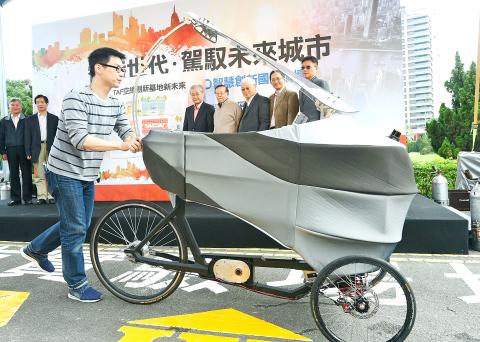A new autonomous tricycle — the result of a joint research effort by Taiwanese institutions and the Massachusetts Institute of Technology’s (MIT) Media Lab for smart city solutions — is to be tested in the Taiwan Air Force Innovation Base over the next 12 months.
“The smart autonomous tricycle could play a key role in future public transportation solutions in smart cities. We thank MIT for inviting Taiwan to participate in the research, development and manufacturing of the product,” Premier Mao Chi-kuo (毛治國) said at a news conference in Taipei yesterday.
The autonomous tricycle, dubbed the Persuasive Electric Vehicle (PEV), was developed and manufactured by the MIT Media Lab, the government-backed Institute of Information Industry (III, 資策會) and local bicycle manufacturer Pacific Cycles Inc (太平洋自行車).

Photo: Chang Chia-ming, Taipei Times
The 90 percent Taiwan-made smart vehicle was showcased at the Consumer Electronics Show in Las Vegas last week. The annual tech extravaganza concluded on Saturday.
MIT Media Lab research fellow and PEV project leader Michael Lin (林家樑) said the smart vehicle can navigate on its own or be directed by a passenger.
Lin said the smart tricycle is not meant to be personally owned, but would be the property of a city — similar to the YouBike system in Taipei.
“It can serve as a public bicycle with passengers and it can also be loaded with goods and travel autonomously,” Lin told reporters on the sidelines of the news conference.
The PEV uses radar, camera lenses, sensor modules and artificial intelligence deep learning, Lin said, adding that the vehicle can calculate the shortest route between two destinations and make a detour in accordance with realtime traffic.
“The tricycle fits in bicycle lanes and reaches speeds of 25kph,” he said. “The specifications of the vehicle are similar to electric bicycles.”
Lin said the research and development team had tested the vehicle by delivering goods in New York.
“PEV could conserve 60 percent of the energy of other autonomous vehicles and the driving distance is 40 percent shorter,” he said.
“Other than transportation solutions, governments could also use the vehicle for surveillance, uploading camera footage via data uploads and storing the information in the cloud,” Lin said.
“The vehicle is an example of the utilization of big data and the Internet-of-things,” he added.
Further testing of the vehicle would be needed because it must learn to become familiar with new environments, Lin said.
He said the MIT Media Lab is in talks with Pacific Cycles to produce 50 tricycles, with 10 of them to be tested in Taiwan and the rest to be tested in Singapore, Andorra, Germany and the US in the second half of the year.
“We anticipate people in Taipei will be able to test drive the PEV at the former air force base before the end of this year,” he said.
Lin said the Media Lab has invested more than US$2 million in the past few years into the project, adding that the team hopes to lower manufacturing costs for each bike to less than NT$200,000 (US$5,970).

CHIP RACE: Three years of overbroad export controls drove foreign competitors to pursue their own AI chips, and ‘cost US taxpayers billions of dollars,’ Nvidia said China has figured out the US strategy for allowing it to buy Nvidia Corp’s H200s and is rejecting the artificial intelligence (AI) chip in favor of domestically developed semiconductors, White House AI adviser David Sacks said, citing news reports. US President Donald Trump on Monday said that he would allow shipments of Nvidia’s H200 chips to China, part of an administration effort backed by Sacks to challenge Chinese tech champions such as Huawei Technologies Co (華為) by bringing US competition to their home market. On Friday, Sacks signaled that he was uncertain about whether that approach would work. “They’re rejecting our chips,” Sacks

NATIONAL SECURITY: Intel’s testing of ACM tools despite US government control ‘highlights egregious gaps in US technology protection policies,’ a former official said Chipmaker Intel Corp has tested chipmaking tools this year from a toolmaker with deep roots in China and two overseas units that were targeted by US sanctions, according to two sources with direct knowledge of the matter. Intel, which fended off calls for its CEO’s resignation from US President Donald Trump in August over his alleged ties to China, got the tools from ACM Research Inc, a Fremont, California-based producer of chipmaking equipment. Two of ACM’s units, based in Shanghai and South Korea, were among a number of firms barred last year from receiving US technology over claims they have

BARRIERS: Gudeng’s chairman said it was unlikely that the US could replicate Taiwan’s science parks in Arizona, given its strict immigration policies and cultural differences Gudeng Precision Industrial Co (家登), which supplies wafer pods to the world’s major semiconductor firms, yesterday said it is in no rush to set up production in the US due to high costs. The company supplies its customers through a warehouse in Arizona jointly operated by TSS Holdings Ltd (德鑫控股), a joint holding of Gudeng and 17 Taiwanese firms in the semiconductor supply chain, including specialty plastic compounds producer Nytex Composites Co (耐特) and automated material handling system supplier Symtek Automation Asia Co (迅得). While the company has long been exploring the feasibility of setting up production in the US to address

OPTION: Uber said it could provide higher pay for batch trips, if incentives for batching is not removed entirely, as the latter would force it to pass on the costs to consumers Uber Technologies Inc yesterday warned that proposed restrictions on batching orders and minimum wages could prompt a NT$20 delivery fee increase in Taiwan, as lower efficiency would drive up costs. Uber CEO Dara Khosrowshahi made the remarks yesterday during his visit to Taiwan. He is on a multileg trip to the region, which includes stops in South Korea and Japan. His visit coincided the release last month of the Ministry of Labor’s draft bill on the delivery sector, which aims to safeguard delivery workers’ rights and improve their welfare. The ministry set the minimum pay for local food delivery drivers at